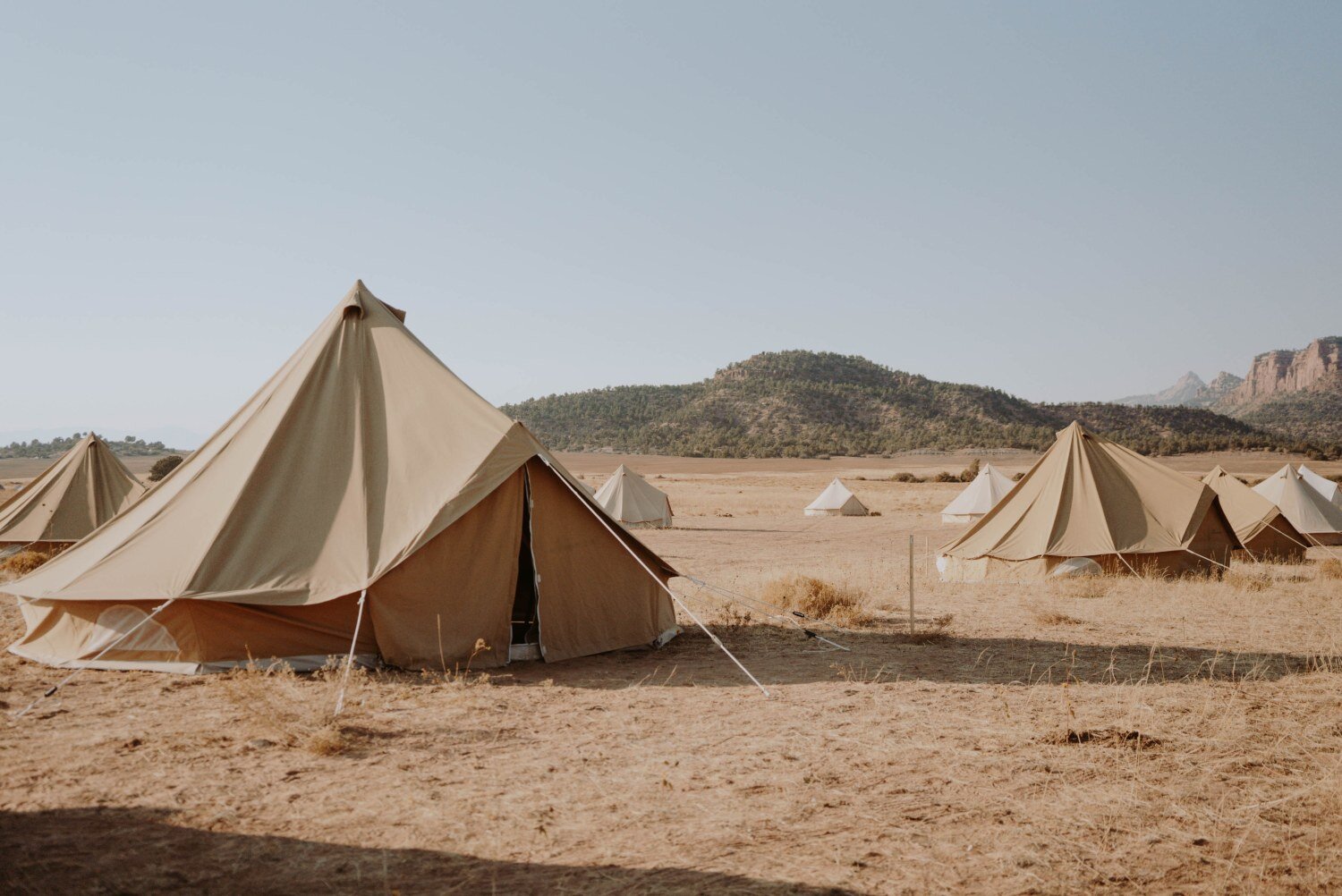Choosing your Glamping Accommodation
If you go camping, you will obviously need to buy a tent and get to grips with how to erect it. Choosing to go glamping, however, means that the tiresome task of assembling a confusing array of poles and canvas sections with no instructions and pegging endless loops and lines to the ground with no hammer (I forgot it, could we use a shoe?) is someone else’s job.
This doesn’t mean that you don’t need to give a moment’s thought to what you’ll be spending your nights in. There are a dizzy and exciting array of choices in the glamping world when it comes to choosing your shelter.
Don’t know your bell tent from your bothy? Here’s a quick rundown of some of the common glamping structures that you’re likely to encounter.
Canvas Structures
Embodying a certain magical quality, canvas structures are the classic and timeless glamping shelters. As we discussed in What is Glamping?, a good glamping experience should aim to build upon the memorable experiences of a camping trip, adding comfort and hopefully a little luxury. It is perhaps obvious then why canvas structures led the way at the beginning of the glamping revolution.
Here is a brief description of the four main options you will come across:
Bell tent
The most ‘tent-like’ of the canvas option, the bell tent was modelled on the design of a teepee and adapted to be quick and easy to set up for use in military applications. They are pitched using a central pole to support the canvas, which is held taut with guy ropes. This is the smallest option, typically designed for sleeping and relaxing but without cooking facilities, and can lack head room, particularly around the edge. They are an attractive shape and certainly have a magical quality to them, but their size can be restrictive.
Teepee
The traditional home of the nomadic Native American tribes. The teepee (or tipi) uses a number or poles, spread in a circle at the bottom and meeting at the top, creating an upside down conical shape. The poles are then wrapped in buffalo hide or, if you are lucky, a modern, breathable, waterproof canvas. Again, they can lack head room at the outer edge, but tend to be larger than a bell tent and the sense of space created by the tall central pole provides a satisfyingly grand feel.
Yurt
Yurts were (and still are in some places) the homes of nomadic people of countries across central Asia (Mongolia, Kazakhstan, etc). Their homes were a deep and important part of their culture and history and embodied the strength and resilience of the people. The crown (or Shangyrak in the Kazakh language) of the family yurt was passed on from father to son across generations. I particularly love the circular shape and the magnificent domed roof with a skylight at the central point. This shape is very strong (providing incredible protection from the harsh landscape of the Asian Steppe as well as occasionally strong rural Norfolk winds) and creates an enchanting and spacious living area with plenty of headroom throughout which, owing to the skylight, has a bright and airy feel. Some yurts include cooking and dining spaces in addition to sleeping and lounging. The skylight is a truly magical feature that brings in light and draws your focus up into the sky above. Stargazing from your bed anyone? We would highly recommend the experience of glamping in a yurt; its partly what made us fall in love with glamping.
Safari tent
Popular in the 1900s with wealthy Europeans on safari in Africa. These tents provided a comfortable and luxurious space for foreign visitors who came to experience the wilderness of Africa. They are essentially a house, or lodge that’s made of canvas. They can have separate rooms, kitchens, ensuite toilets and even an upstairs, so if privacy within your group is important, then they can be a good option. Some of the potential magic is lost in the ordinariness of the square space although hosts use their creativity to make the inside feel special. There isn’t much to give you a sense that you are truly somewhere special and different to the everyday.
Traditional structures
A growing and exciting trend is to glampify (i’m sure that’s a word) traditional structures. Perhaps following on from the use of traditional yurts and teepees for glamping use, glampsites are getting creative with all manner of interesting traditional spaces. These are generally beautiful, well-crafted structures that are chosen because of their connection to the natural surroundings, their capacity to ignite your imagination and, of course, the ability to keep you cosy and comfortable. In addition to beds for a good night’s sleep these structures generally including ensuites and kitchen facilities as well as dining areas. They are modernised, often full of creative touches, and are the ideal choice for those looking for something a bit different.
Some options you may discover:
Roundhouse
Our top recommendation for glamping in Norfolk. A roundhouse is a traditional type of housing found in Britain from the Bronze age and beyond. Circular in shape and with a conical roof, the design has been developed and used in many modern eco-builds, incorporating materials such as straw or earth. They may also feature a self supporting, reciprocal roof and a skylight, which creates a large, bright, open plan space with a magical feeling similar to that experienced in a yurt. The natural walls create a serene sense of peace due to their soft curves and impressive sound insulation properties, as well as maintaining a comfortable temperature and superior protection from the elements.
Bothy
A traditional hut found in remote, mountainous areas of Scotland, to provide shelter freely to people travelling or working in the mountains. They often have the look of a small cottage, are very basic in their provision and layout and are usually accessible only by foot or on bike, which in itself creates a feeling of adventure and escape from the everyday. Of course, a glamping bothy will have the benefit of proper facilities and comfortable furnishings, in addition to the remote location and quaintness of the shelter.
Roulotte (and other gypsy caravans)
A Roulotte is the traditional home of gypsy travellers in France. Originally used to simply carry their belongings, in the 19th century these caravans became their homes on wheels as they began to add doors, windows and stoves. There is a definite charm to the shape, including a curved roof, which gives the space a romantic feel.
Shepherds hut
A small, cosy hut on wheels. Providing traditional shepherds basic shelter and a place to cook and sleep, as far back as the 16th century. Shepherds huts used for glamping are often creatively furnished, making efficient use of the small space. They usually have a stove, a fixed bed at one end and a comfortable sitting area with views over a typically rural setting. This is a great choice for a romantic couples holiday.
Fisherman/ woodsmans cabin
Found in remote locations across the country, these are simple wooden cabins found in the woods, or by lakes, where these workers would spend their nights. They would have been very basic, as the worker would have brought all they needed for the stay, however you will find some that have been renovated and given a new lease of life as comfortable glamping structures, in remote locations.
Pods
Pods, sometimes known as cabins, are like high end wooden sheds. They are often built to mimic a more traditional structure like a tent or a gypsy caravan, but they are more solid and often include a range of facilities to enhance your comfort. They’re generally weatherproof, insulated and comfortable and will provide a suitable introduction to the world of glamping. However, for me they lack the inspiring uniqueness and magical feeling inherent in many other glamping offerings. Their simple, off-the-shelf nature leaves them with little in the way of personality and those looking for something particularly special could be disappointed. Pods can be unfurnished, with a place to lay your sleeping bag or fully furnished with mod cons including underfloor heating, televisions and kitchen facilities.
Treehouses
If you are looking for a timber structure with a little more in the way of personality, then a treehouse may be what you are looking for. There is something particularly awe inspiring about getting up high in the canopy.
Beware, some ‘treehouse’ structures aren’t exactly treehouses - more like cabins on a platform near some trees - while others are beautiful, imaginative, creative feats of architecture and engineering. The reason for this is that building safely around something living and moving is a tricky thing to pull off and can be a very technical and expensive project. A stay in a proper treehouse will be at the higher end of the market’s price range, but will certainly be a memorable experience.
Vehicles
The creativity and ingenuity of people in the glamping world never ceases to amaze me and, among the many options, you will find some very original and imaginative vehicle conversions in your search for the perfect place to stay. Each one of these is different and will have their individual merits, so you will have to look carefully at the available options. When making a decision, remember to keep in mind that the best glamping experiences are those with a clear connection to the natural surroundings and a deliberate association with the experience of traditional camping. Some examples of craftily and comfortably converted vehicles that will serve to create a memorable and unusual holiday include buses, caravans, wagons, trains, boats, planes and helicopters.
Which of these many structures excites and inspires you the most? Have you stayed in any other unusual glamping structures? Let us know and if you’ve got any questions, we’d love to hear from you.
Comment below and if you enjoyed this post, please share it with a friend.
Further Reading - An Introduction to Luxury Glamping Series














